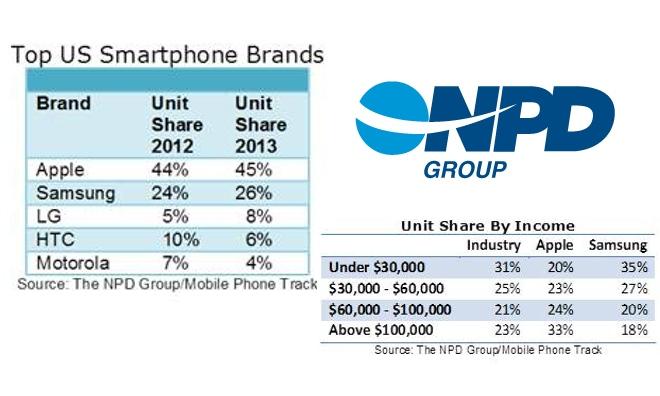With more than 120 million smartphones sold in the U.S. in 2013, Apple's iPhone accounted for nearly half of those, taking a 45 percent share in its home market last year, new data released by the NPD Group on Thursday reveals.
The research firm's latest Mobile Phone Track shows that of 121 million smartphones sold last year in America, the iPhone accounted for 45 percent, making Apple the largest smartphone maker in the U.S. Overall smartphone sales were up 21 percent year over year.
The iPhone proved most popular among consumers earning $100,000 or more per year, while Samsung devices were more popular with those who earn less than $30,000.
Apple's overall share was up slightly from 2012, when the company commanded a 44 percent share of the market. Second-place Samsung also saw it share gain slightly, from 24 percent in 2012 to 26 percent in 2013.
Lagging behind the two-horse race was LG, which represented 8 percent of smartphones sold in America last year. HTC took fourth with 6 percent, while Motorola came in fifth with 4 percent.
Apple's iPhone proved more popular among smartphone users who earn more than $100,000 per year, taking a 33 percent share among those buyers compared to Samsung's 18 percent. And Samsung's lower-priced options proved more popular than the iPhone for those who earn $60,000 or less in the U.S.
Still, NPD said that iPhone sales grew 64 percent among lower income customers who earn under $30,000 last year. However, that market segment accounted for just 20 percent of total 2013 iPhone sales.
"With the fastest growing segments of the industry in the lowest income demographics, both Apple and Samsung face challenges in 2014," said Stephen Baker, vice president of industry analysis at NPD. "For Samsung this demographic is likely to be the most competitive segment of the market in 2014 and they have a very high dependency on sales here. Apple has the opposite problem of gaining share in the fast growing entry-level market while still maintaining its position as the dominant supplier to affluent consumers."
Most of the mobile industry's growth seen in the U.S. in 2013 came from prepaid devices, which grew 68 percent last year, NPD said. Prepaid devices also accounted for 29 percent of the smartphone market, up from 14 percent in 2011.
While prepaid devices surged, postpaid devices still reign, accounting for 71 percent of handsets sold last year. Sales of postpaid devices increased by less than 10 percent in 2013.
The NPD Mobile Phone Track measures activities of U.S. consumers 18 or older who purchase a mobile phone or smartphone. The figures do not include corporate mobile phone purchases.
"In general, 2013 was a year of smartphone market stability for the U.S,," Baker said. "Overall industry growth was similar to that of 2012, and while the major hardware brands saw their shares increase marginally, the space between Apple and Samsung and the rest of the industry expanded once again."
 Neil Hughes
Neil Hughes







-m.jpg)






 Charles Martin
Charles Martin
 Christine McKee
Christine McKee
 Wesley Hilliard
Wesley Hilliard
 Malcolm Owen
Malcolm Owen
 Andrew Orr
Andrew Orr
 William Gallagher
William Gallagher
 Sponsored Content
Sponsored Content







69 Comments
they sold more than anyone else? that is terrible business- Wall Street will make sure they pay for such a poor, underwhelming performance.
Not only did Apple sell more, it earned more than the other mobile phone companies. Yes, Wall Street will find a reason to ding Apple's performance.
they sold more than anyone else? that is terrible business- Wall Street will make sure they pay for such a poor, underwhelming performance.
Well, "obviously," their rate of growth has shrunk compared to Samsung, therefore, ipso facto, cogito ergo sum idiot, their stock value is wildly over -valued and a "market correction" will make it more in line with reality, since there is no room for growth, they're not making a cheaper iPhone, they charge too much, they're not open, they use a walled garden, and Mercury must be retrograde.
(wow ... I think I just sprained something trying to fit so much garbage into one sentence!)
[quote name="Dave MacLachlan" url="/t/162113/apples-iphone-led-2013-us-consumer-smartphone-sales-with-45-share-npd#post_2474858"]Well, "obviously," their rate of growth has shrunk compared to Samsung, therefore, ipso facto, cogito ergo sum idiot, their stock value is wildly over -valued and a "market correction" will make it more in line with reality, since there is no room for growth, they're not making a cheaper iPhone, they charge too much, they're not open, they use a walled garden, and Mercury must be retrograde. (wow ... I think I just sprained something trying to fit so much garbage into one sentence!) [/quote] I think you nailed it ... take an aspirin and go to bed for a rest you earned it. :D
Quite impressive considering that their 3-4 year old products are still selling like hot cakes, the 4 and 4S still going strong, at lower and lower production cost... it speaks volumes about the customer loyalty that they have earned. The new line of 2014 products with iPhone 6, iPad Pro, iWatch/health device, iTV, Mac Pro etc will only propel their share of wallet further upwards, and then all this nonsense talk of "smartphone market share" can finally stop. It is not about phones anymore... AAPL is repositioning themselves behind the scene, but try and explain that to IDC, Gartner, NPD and friends...